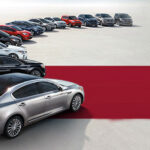Kia was founded in December 1944 as part of Hyungsung Precision Industry, a manufacturer of steel tubes and bicycle parts. The company’s initial factory was situated in Yougdeungpo, in the southern region of Seoul.
In March 1952, the factory produced its first domestic bicycle named Samcholli-ho and subsequently changed its name to Kia Industrial Company. The word “Kia” is a combination of two Chinese characters, “ki” meaning “growth” and “a” meaning “Asia”. Hence, Kia can be roughly translated as “Growth over Asia”.
In the following decade, when the Korean automotive industry began to emerge, Kia introduced the C-100 motorcycle. Merely three months after, the Shiheung production line of Kia started manufacturing three-wheeled trucks known as K360. This production continued until 1973, during which the company sold 25,000 units. Motorcycle production, however, was discontinued in 1981.
In 1971, large four-wheeled trucks were brought to the market by Kia, which eventually made their way across South Korea. The name “Titan”, meaning “large”, became synonymous with “truck”. Kia was the first company to manufacture gasoline engines in 1973 and, in October 1974, it launched the first passenger car in Korea, the Brisa. Later, the Brisa became the first Korean car to be exported to the Middle East. The first gasoline engine in Korea was also produced in 1978.
Until 1979, Kia continued to produce the Peugeot 604 and Fiat 132 sedans. Then, in 1986, Kia partnered with the Ford Motor Company to produce small cars such as the Pride or Festiva, followed by the Ford Aspire. The deployment of the Pride model unfolded at Kia’s inaugural dedicated Research and Development center, established in October 1984 in Sohari, near Seoul. This center resulted from the merger of two domestic centers and four foreign Research and Development centers and was opened in Japan in 1989.
In 1992, Kia formed a branch in the United States known as Kia Motors America. By 1994, Kia had officially entered the US market and began selling cars through its dealer network, starting in California. In 1993, the European market was also tapped into with the introduction of the Sephia passenger car.
In 1997, the Asian financial crisis took its toll on Kia Motors, leading the company to diversify its product line. Hyundai assumed control of Kia in 1998, marking the beginning of a new era. By 1999, Kia had successfully returned to profitability and continued to grow as it had previously accomplished. With the establishment of the Hyundai Motor Group in September 2000, Kia truly entered a phase of growth through research and development and production cooperation.
By 2002, Kia had manufactured ten million vehicles. The Carnival/Sedona minivan and the Sorento SUV, both iconic models, helped propel the company’s focus towards product quality and customer appeal. In 2002, Kia also became the primary sponsor of a tennis tournament in Australia.
Today, Kia Motors has a global presence in 160 countries. As part of the Hyundai Kia Automotive Group, Kia Motors conducts retail operations through a distribution network in 160 countries worldwide. Additionally, Kia Motors has 10 overseas branches and 4 R&D centers, including 2 in the United States and 2 in Europe and Japan.






























![[CAR REVIEW] Kia EV6 – Deserving of the title “Trailblazer”](https://vnauto.net/wp-content/uploads/2023/10/xehay-kia-ev6-240122-10-150x150.jpg)
![[VIDEO] First Look at the Kia Tasman Pickup Truck – Powerful Design, Unmatched Versatility](https://vnauto.net/wp-content/uploads/2024/01/xehay-Kia-051222-2-150x150.jpg)
![[VIDEO] Kia Tasman Pickup Truck Unveiled for the First Time – Bold Design, Equally Capable as American Trucks.](https://vnauto.net/wp-content/uploads/2024/02/xehay-Kia-051222-2-1-150x150.jpg)











